Tethering (Arene)Ru(II) Acylpyrazolones Decorated with Long Aliphatic Chains to Polystyrene Surfaces Provides Potent Antibacterial Plastics
Abstract
1. Introduction
2. Results
2.1. Synthesis and Characterization of the HQR Proligands
2.2. Synthesis and Characterization Complexes 1–8
2.3. Microbiological Study on Complexes 1–8 and Proligands HQR
2.4. Amphipathic Behavior of Complexes 1–4
2.5. Preparation of Samples PS1–PS4
2.6. Antibacterial Activity of PS1–PS4 According to ISO Standard
3. Materials and Methods
3.1. Synthesis of Precursor 3-heptadecyl-1-phenyl-1H-pyrazol-5(4H)-one HPPh,C17
3.2. Synthesis of Proligand (3-heptadecyl-5-hydroxy-1-phenyl-1H-pyrazol-4-yl)(phenyl)methanone HQPh,C17
3.3. Synthesis of Complex [(Cym)Ru(QPh,C17)Cl] (1)
3.4. Synthesis of Complex [(Hmb)Ru(QPh,C17)Cl] (2)
3.5. Preparation of Samples PS1–PS4
3.6. Antibacterial Activity of Proligands HQR, of Complexes 1–8, and of Samples PS1–PS4
3.6.1. Time-Kill Kinetics Assay
3.6.2. Antibacterial Activity According to ISO Standard
4. Conclusions
Supplementary Materials
Author Contributions
Funding
Acknowledgments
Conflicts of Interest
References
- Alessio, E. Thirty Years of the Drug Candidate NAMI-A and the Myths in the Field of Ruthenium Anticancer Compounds: A Personal Perspective. Eur. J. Inorg. Chem. 2017, 2017, 1549–1560. [Google Scholar] [CrossRef]
- Su, W.; Tang, Z.; Li, P. Development of Arene Ruthenium Antitumor Complexes. Mini Rev. Med. Chem. 2016, 16, 787–795. [Google Scholar] [CrossRef] [PubMed]
- Abid, M.; Shamsi, F.; Azam, A. Ruthenium Complexes: An Emerging Ground to the Development of Metallopharmaceuticals for Cancer Therapy. Mini Rev. Med. Chem. 2016, 16, 772–786. [Google Scholar] [CrossRef] [PubMed]
- Burris, H.A.; Bakewell, S.; Bendell, J.C.; Infante, J.; Jones, S.F.; Spigel, D.R.; Weiss, G.J.; Ramanathan, R.K.; Ogden, A.; Von Hoff, D. Safety and Activity of IT-139, a Ruthenium-Based Compound, in Patients with Advanced Solid Tumours: A First-in-Human, Open-Label, Dose-Escalation Phase I Study with Expansion Cohort. ESMO Open 2016, 1, e000154. [Google Scholar] [CrossRef] [PubMed]
- Lentz, F.; Drescher, A.; Lindauer, A.; Henke, M.; Hilger, R.A.; Hartinger, C.G.; Scheulen, M.E.; Dittrich, C.; Keppler, B.K.; Jaehde, U. Pharmacokinetics of a Novel Anticancer Ruthenium Complex (KP1019, FFC14A) in a Phase I Dose-Escalation Study. Anticancer Drugs 2009, 20, 97–103. [Google Scholar] [CrossRef]
- Leijen, S.; Burgers, S.A.; Baas, P.; Pluim, D.; Tibben, M.; van Werkhoven, E.; Alessio, E.; Sava, G.; Beijnen, J.H.; Schellens, J.H.M. Phase I/II Study with Ruthenium Compound NAMI-A and Gemcitabine in Patients with Non-Small Cell Lung Cancer after First Line Therapy. Investig. New Drugs 2015, 33, 201–214. [Google Scholar] [CrossRef]
- Rademaker-Lakhai, J.M.; van den Bongard, D.; Pluim, D.; Beijnen, J.H.; Schellens, J.H.M. A Phase I and Pharmacological Study with Imidazolium-Trans-DMSO-Imidazole-Tetrachlororuthenate, a Novel Ruthenium Anticancer Agent. Clin. Cancer Res. 2004, 10, 3717–3727. [Google Scholar] [CrossRef]
- Alessio, E.; Messori, L. The Deceptively Similar Ruthenium (III) Drug Candidates KP1019 and NAMI-A Have Different Actions. What Did We Learn in the Past 30 Years? Met. Dev. Action Anticancer Agents 2018, 18, 141. [Google Scholar]
- Englinger, B.; Pirker, C.; Heffeter, P.; Terenzi, A.; Kowol, C.R.; Keppler, B.K.; Berger, W. Metal Drugs and the Anticancer Immune Response. Chem. Rev. 2019, 119, 1519–1624. [Google Scholar] [CrossRef]
- Monro, S.; Colón, K.L.; Yin, H.; Roque, J.; Konda, P.; Gujar, S.; Thummel, R.P.; Lilge, L.; Cameron, C.G.; McFarland, S.A. Transition Metal Complexes and Photodynamic Therapy from a Tumor-Centered Approach: Challenges, Opportunities, and Highlights from the Development of TLD1433. Chem. Rev. 2019, 119, 797–828. [Google Scholar] [CrossRef]
- Biersack, B. Anticancer Activity and Modes of Action of (Arene) Ruthenium (II) Complexes Coordinated to C-, N-, and O-Ligands. Mini Rev. Med. Chem. 2016, 16, 804–814. [Google Scholar] [CrossRef] [PubMed]
- Zheng, K.; Wu, Q.; Ding, Y.; Mei, W. Arene Ruthenium (II) Complexes: The Promising Chemotherapeutic Agent in Inhibiting the Proliferation, Migration and Invasion. Mini Rev. Med. Chem. 2016, 16, 796–803. [Google Scholar] [CrossRef] [PubMed]
- Nazarov, A.A.; Mendoza-Ferri, M.-G.; Hanif, M.; Keppler, B.K.; Dyson, P.J.; Hartinger, C.G. Understanding the Interactions of Diruthenium Anticancer Agents with Amino Acids. JBIC J. Biol. Inorg. Chem. 2018, 23, 1159–1164. [Google Scholar] [CrossRef] [PubMed]
- Gambino, D.; Otero, L. Design of Prospective Antiparasitic Metal-Based Compounds Including Selected Organometallic Cores. Inorg. Chim. Acta 2018, 472, 58–75. [Google Scholar] [CrossRef]
- Allardyce, C.S.; Dyson, P.J.; Ellis, D.J.; Salter, P.A.; Scopelliti, R. Synthesis and Characterisation of Some Water Soluble Ruthenium (II)–Arene Complexes and an Investigation of Their Antibiotic and Antiviral Properties. J. Organomet. Chem. 2003, 668, 35–42. [Google Scholar] [CrossRef]
- Li, F.; Collins, J.G.; Keene, F.R. Ruthenium Complexes as Antimicrobial Agents. Chem. Soc. Rev. 2015, 44, 2529–2542. [Google Scholar] [CrossRef]
- Smith, N.A.; Zhang, P.; Greenough, S.E.; Horbury, M.D.; Clarkson, G.J.; McFeely, D.; Habtemariam, A.; Salassa, L.; Stavros, V.G.; Dowson, C.G. Combatting AMR: Photoactivatable Ruthenium (II)-Isoniazid Complex Exhibits Rapid Selective Antimycobacterial Activity. Chem. Sci. 2017, 8, 395–404. [Google Scholar] [CrossRef]
- Laurent, Q.; Batchelor, L.K.; Dyson, P.J. Applying a Trojan Horse Strategy to Ruthenium Complexes in the Pursuit of Novel Antibacterial Agents. Organometallics 2018, 37, 915–923. [Google Scholar] [CrossRef]
- Lagarón, J.M.; Ocio, M.J.; López-Rubio, A. Antimicrobial Polymers; John Wiley & Sons: Hoboken, NJ, USA, 2011. [Google Scholar]
- Muñoz-Bonilla, A.; Cerrada, M.L.; Fernández-García, M. CHAPTER 1. Introduction to Antimicrobial Polymeric Materials. In Polymeric Materials with Antimicrobial Activity: From Synthesis to Applications; Royal Society of Chemistry: London, UK, 2013; Volume 10, pp. 1–21. [Google Scholar]
- Simbine, E.O.; Rodrigues, L.C.; Lapa-Guimarães, J.; Kamimura, E.S.; Corassin, C.H.; Oliveira, C.A.F. Application of Silver Nanoparticles in Food Packages: A Review. Food Sci. Technol. 2019. [Google Scholar] [CrossRef]
- Chernousova, S.; Epple, M. Silver as Antibacterial Agent: Ion, Nanoparticle, and Metal. Angew. Chem. Int. Ed. 2013, 52, 1636–1653. [Google Scholar] [CrossRef]
- Marchetti, F.; Palmucci, J.; Pettinari, C.; Pettinari, R.; Marangoni, M.; Ferraro, S.; Giovannetti, R.; Scuri, S.; Grappasonni, I.; Cocchioni, M.; et al. Preparation of Polyethylene Composites Containing Silver(I) Acylpyrazolonato Additives and SAR Investigation of Their Antibacterial Activity. ACS Appl. Mater. Interfaces 2016, 8, 29676–29687. [Google Scholar] [CrossRef] [PubMed]
- Tǎbǎcaru, A.; Pettinari, C.; Marchetti, F.; Di Nicola, C.; Domasevitch, K.V.; Galli, S.; Masciocchi, N.; Scuri, S.; Grappasonni, I.; Cocchioni, M. Antibacterial Action of 4,4′-Bipyrazolyl-Based Silver(I) Coordination Polymers Embedded in PE Disks. Inorg. Chem. 2012, 51, 9775–9788. [Google Scholar] [CrossRef] [PubMed]
- Marchetti, F.; Palmucci, J.; Pettinari, C.; Pettinari, R.; Condello, F.; Ferraro, S.; Marangoni, M.; Crispini, A.; Scuri, S.; Grappasonni, I.; et al. Novel Composite Plastics Containing Silver(I) Acylpyrazolonato Additives Display Potent Antimicrobial Activity by Contact. Chem. Eur. J. 2015, 21, 836–850. [Google Scholar] [CrossRef] [PubMed]
- Pettinari, R.; Marchetti, F.; Condello, F.; Pettinari, C.; Lupidi, G.; Scopelliti, R.; Mukhopadhyay, S.; Riedel, T.; Dyson, P.J. Ruthenium(II)-Arene RAPTA Type Complexes Containing Curcumin and Bisdemethoxycurcumin Display Potent and Selective Anticancer Activity. Organometallics 2014, 33, 3709–3715. [Google Scholar] [CrossRef]
- Pettinari, R.; Condello, F.; Marchetti, F.; Pettinari, C.; Bautista-Toledo, M.I.; Morales-Torres, S.; Dyson, P.J.; Maldonado-Hódar, F.J. Composite Materials Based on (Cymene)Ru(II) Curcumin Additives Loaded on Porous Carbon Adsorbents from Agricultural Residues Display Efficient Antibacterial Activity. ACS Appl. Bio Mater. 2018, 1, 153–159. [Google Scholar] [CrossRef]
- Sultan, M.; El-Sharkawy, I.I.; Miyazaki, T.; Saha, B.B.; Koyama, S. An Overview of Solid Desiccant Dehumidification and Air Conditioning Systems. Renew. Sustain. Energy Rev. 2015, 46, 16–29. [Google Scholar] [CrossRef]
- Pettinari, R.; Pettinari, C.; Marchetti, F.; Skelton, B.W.; White, A.H.; Bonfili, L.; Cuccioloni, M.; Mozzicafreddo, M.; Cecarini, V.; Angeletti, M.; et al. Arene-Ruthenium(II) Acylpyrazolonato Complexes: Apoptosis-Promoting Effects on Human Cancer Cells. J. Med. Chem. 2014, 57, 4532–4542. [Google Scholar] [CrossRef]
- Caruso, F.; Monti, E.; Matthews, J.; Rossi, M.; Gariboldi, M.B.; Pettinari, C.; Pettinari, R.; Marchetti, F. Synthesis, Characterization, and Antitumor Activity of Water-Soluble (Arene)Ruthenium(II) Derivatives of 1,3-Dimethyl-4-Acylpyrazolon-5-Ato Ligands. First Example of Ru(Arene)(Ligand) Antitumor Species Involving Simultaneous Ru-N7(Guanine) Bonding and Lig. Inorg. Chem. 2014, 53, 3668–3677. [Google Scholar] [CrossRef]
- Palmucci, J.; Marchetti, F.; Pettinari, R.; Pettinari, C.; Scopelliti, R.; Riedel, T.; Therrien, B.; Galindo, A.; Dyson, P.J. Synthesis, Structure, and Anticancer Activity of Arene-Ruthenium(II) Complexes with Acylpyrazolones Bearing Aliphatic Groups in the Acyl Moiety. Inorg. Chem. 2016, 55, 11770–11781. [Google Scholar] [CrossRef]
- Marchetti, F.; Pettinari, R.; Di Nicola, C.; Pettinari, C.; Palmucci, J.; Scopelliti, R.; Riedel, T.; Therrien, B.; Galindo, A.; Dyson, P.J. Synthesis, Characterization and Cytotoxicity of Arene-Ruthenium(II) Complexes with Acylpyrazolones Functionalized with Aromatic Groups in the Acyl Moiety. Dalton Trans. 2018, 47, 868–878. [Google Scholar] [CrossRef]
- Marchetti, F.; Pettinari, R.; Pettinari, C. Recent Advances in Acylpyrazolone Metal Complexes and Their Potential Applications. Coord. Chem. Rev. 2015, 303, 1–31. [Google Scholar] [CrossRef]
- Marchetti, F.; Pettinari, C.; Pettinari, R. Acylpyrazolone Ligands: Synthesis, Structures, Metal Coordination Chemistry and Applications. Coord. Chem. Rev. 2005, 249, 2909–2945. [Google Scholar] [CrossRef]
- Pettinari, C.; Marchetti, F.; Drozdov, A. β-Diketones and Related Ligands. In Comprehensive Coordination Chemistry II; McCleverty, J.A., Meyer, T.J., Eds.; Elsevier: Amsterdam, The Netherlands, 2004; Volume 1, pp. 97–115. [Google Scholar]
- Renfrew, A.K.; Juillerat-Jeanneret, L.; Dyson, P.J. Adding Diversity to Ruthenium (II)–Arene Anticancer (RAPTA) Compounds via Click Chemistry: The Influence of Hydrophobic Chains. J. Organomet. Chem. 2011, 696, 772–779. [Google Scholar] [CrossRef]
- Casini, A.; Edafe, F.; Erlandsson, M.; Gonsalvi, L.; Ciancetta, A.; Re, N.; Ienco, A.; Messori, L.; Peruzzini, M.; Dyson, P.J. Rationalization of the Inhibition Activity of Structurally Related Organometallic Compounds against the Drug Target Cathepsin B by DFT. Dalton Trans. 2010, 39, 5556–5563. [Google Scholar] [CrossRef]
- Wypych, G.; Polystyrene, P.S. Handbook of Polymers; ChemTec Publishing: Toronto, Canada, 2012; pp. 541–547. [Google Scholar]
- Kurteva, V.B.; Petrova, M.A. Synthesis of 3-Methyl-4-(4-Methylbenzoyl)-1-Phenyl-Pyrazol-5-One: How To Avoid O-Acylation. J. Chem. Educ. 2015, 92, 382–384. [Google Scholar] [CrossRef]
- Marchetti, F.; Pettinari, C.; Pettinari, R.; Cerquetella, A.; Cingolani, A.; Chan, E.J.; Kozawa, K.; Skelton, B.W.; White, A.H.; Wanke, R.; et al. Areneruthenium(II) 4-Acyl-5-Pyrazolonate Derivatives: Coordination Chemistry, Redox Properties, and Reactivity. Inorg. Chem. 2007, 46, 8245–8257. [Google Scholar] [CrossRef]
- Thangadurai, T.D.; Natarajan, K. Antibacterial Activity of Ruthenium(II) Carbonyl Complexes Containing Tetradentate Schiff Bases. Transit. Met. Chem. 2002, 27, 485–489. [Google Scholar] [CrossRef]
- Mehta, J.V.; Gajera, S.B.; Patel, M.N. Design, Synthesis and Biological Evaluation of Pyrazoline Nucleus Based Homoleptic Ru (III) Compounds. Medchemcomm 2016, 7, 1367–1380. [Google Scholar] [CrossRef]
- Mehta, J.V.; Gajera, S.B.; Patel, M.N. Biological Applications of Pyrazoline-Based Half-Sandwich Ruthenium (III) Coordination Compounds. J. Biomol. Struct. Dyn. 2017, 35, 1599–1607. [Google Scholar] [CrossRef]
- Mikhaylov, V.N.; Sorokoumov, V.N.; Korvinson, K.A.; Novikov, A.S.; Balova, I.A. Synthesis and Simple Immobilization of Palladium(II) Acyclic Diaminocarbene Complexes on Polystyrene Support as E Ffi Cient Catalysts for Sonogashira and Suzuki−Miyaura Cross-Coupling. Organometallics 2016, 35, 1684–1697. [Google Scholar] [CrossRef]
- Mikhailov, V.N.; Korvinson, K.; Sorokoumov, V.N. Chiral Acyclic Diaminocarbene Complexes of Palladium (II) Immobilized on a Polymeric Support as Promising Catalysts of the Suzuki Reaction. Russ. J. Gen. Chem. 2016, 86, 2473–2476. [Google Scholar] [CrossRef]
- British Standards Institution. International Standard ISO 22196: 2007. Plastics-Measurement of Antibacterial Activity on Plastics Surfaces, 1st ed.; BSI: London, UK, 2007. [Google Scholar]
- Japanese Industrial Standard Community. Testing Method for Antibacterial Activity of Textiles: JIS L 1902; Japanese Standards Association: Tokyo, Japan, 2002. [Google Scholar]
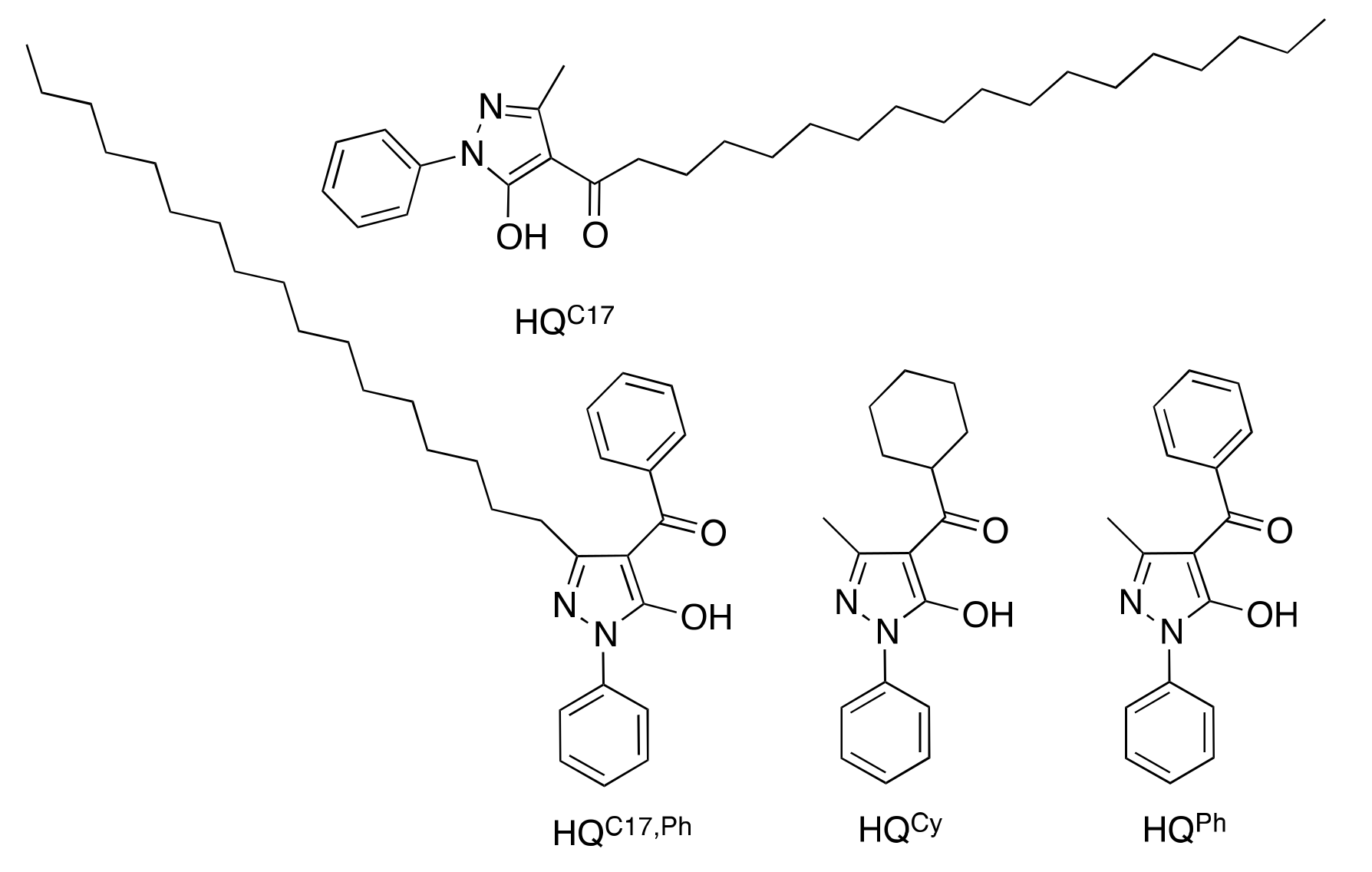
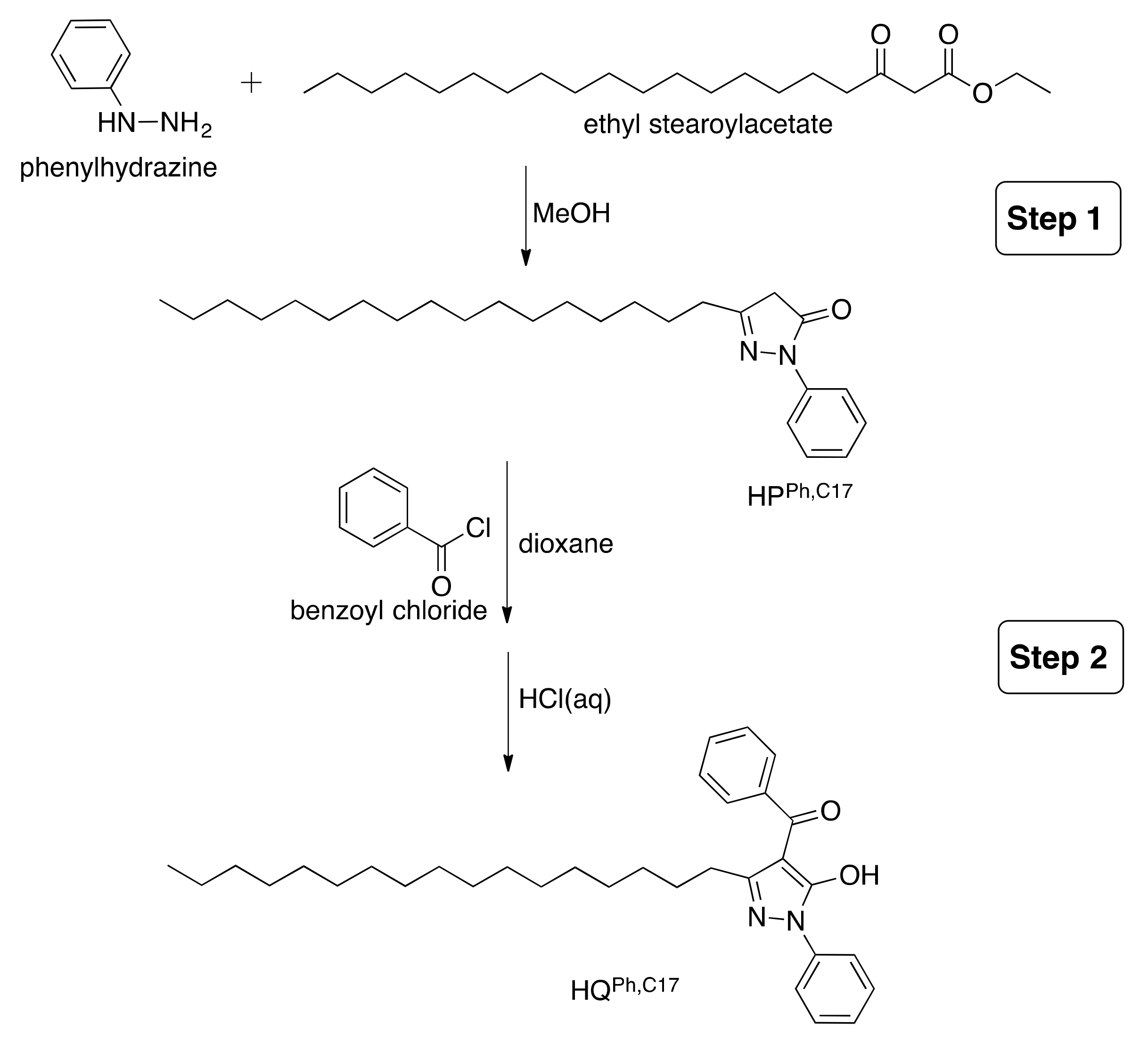



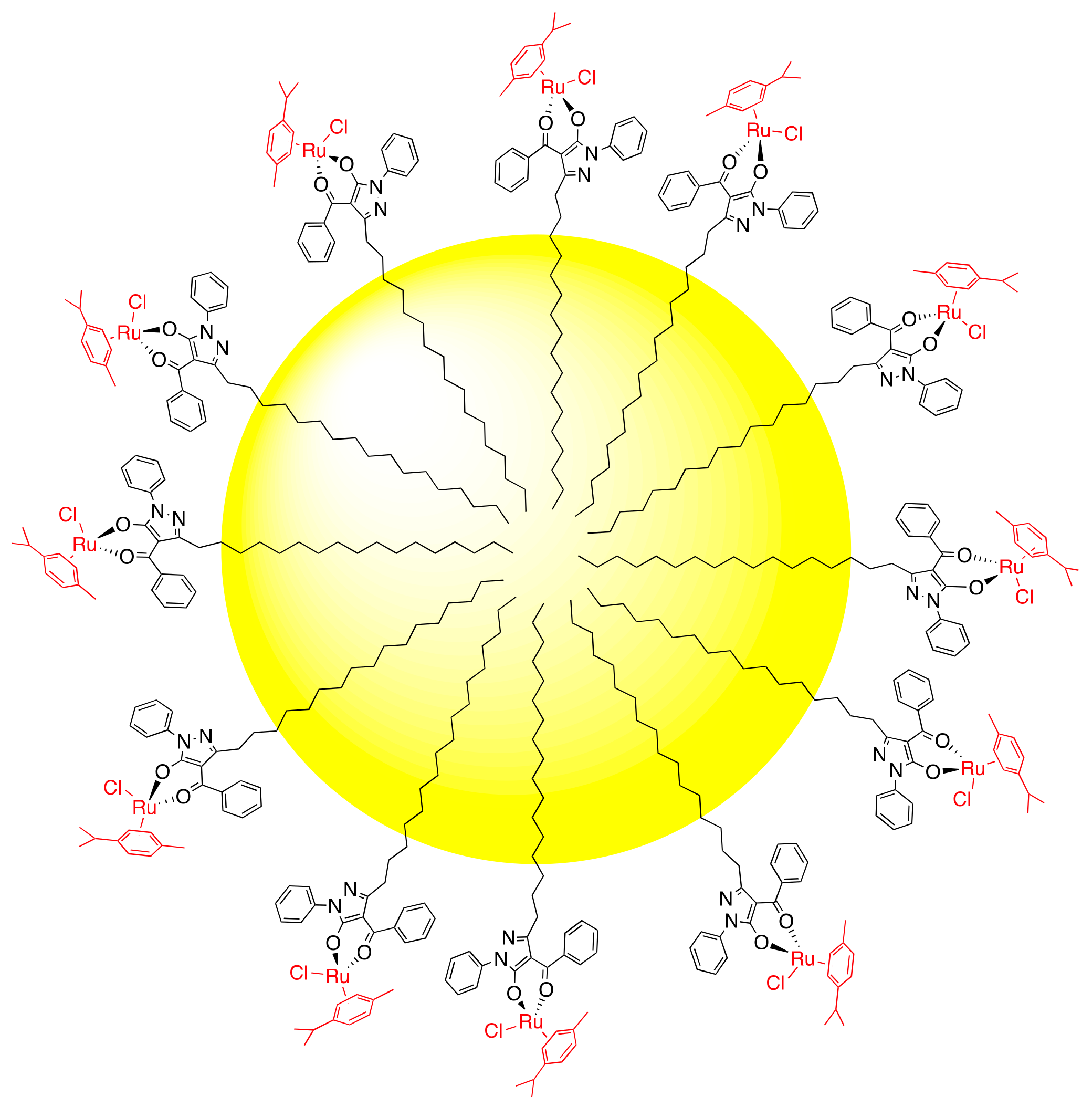

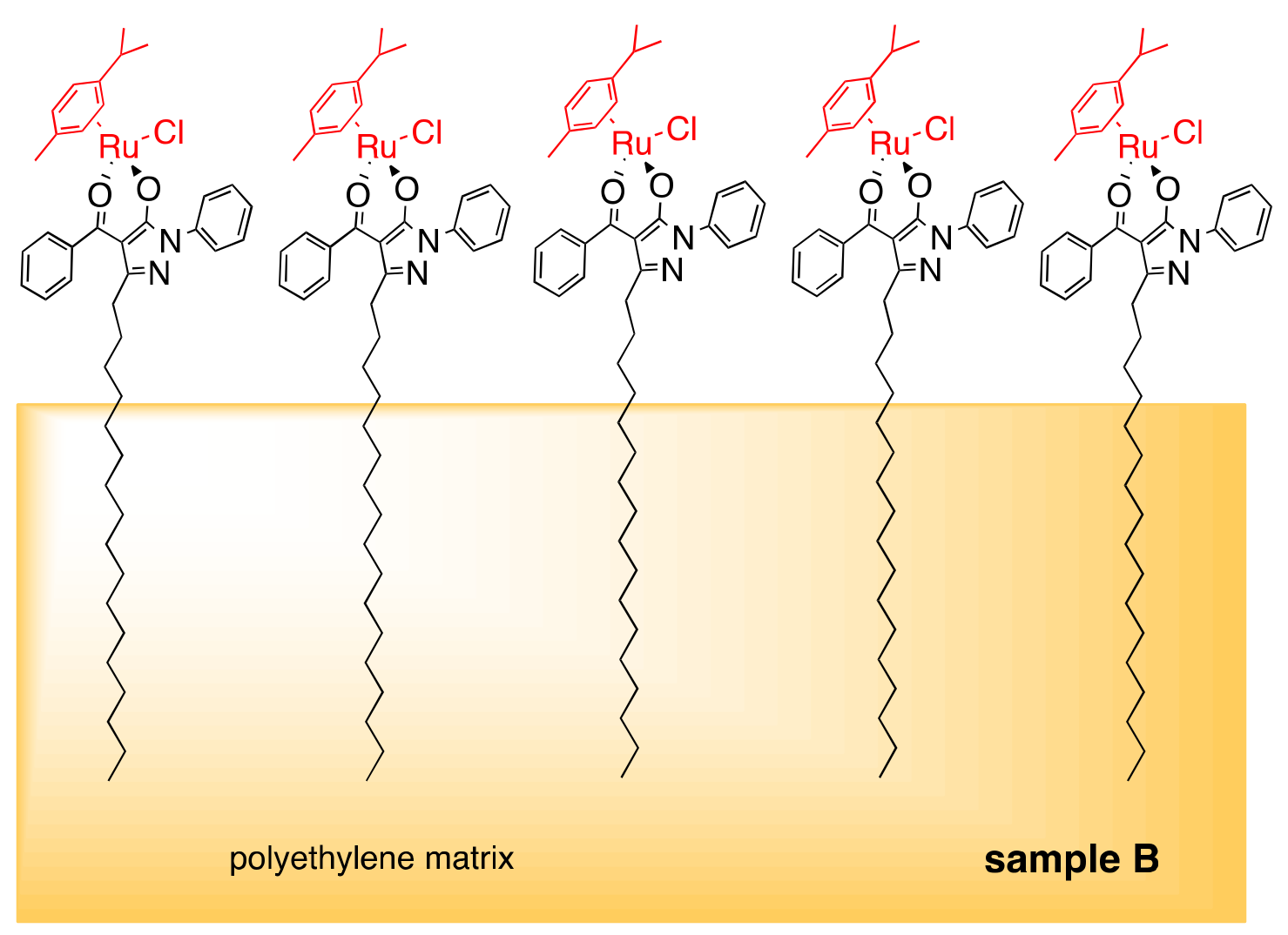
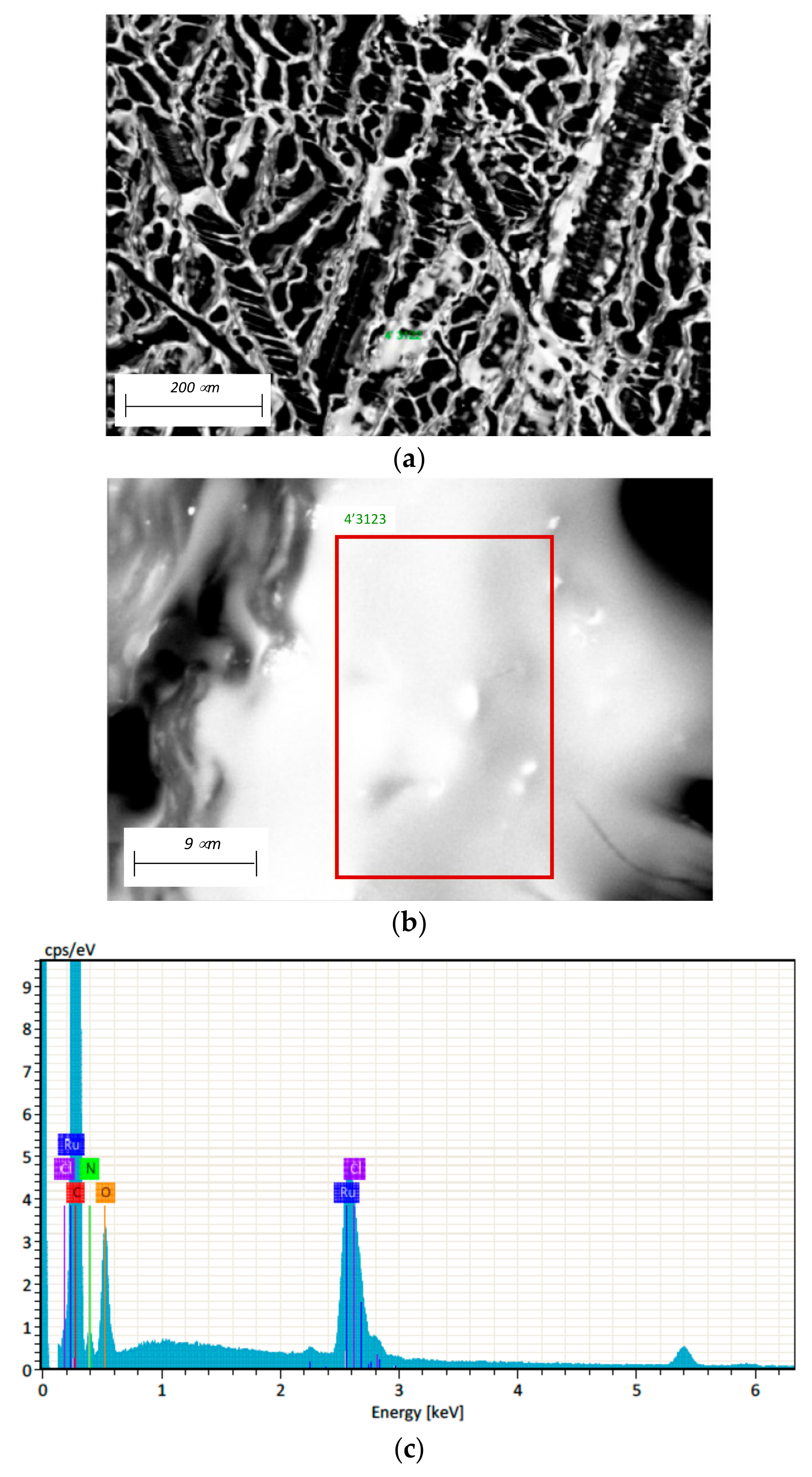
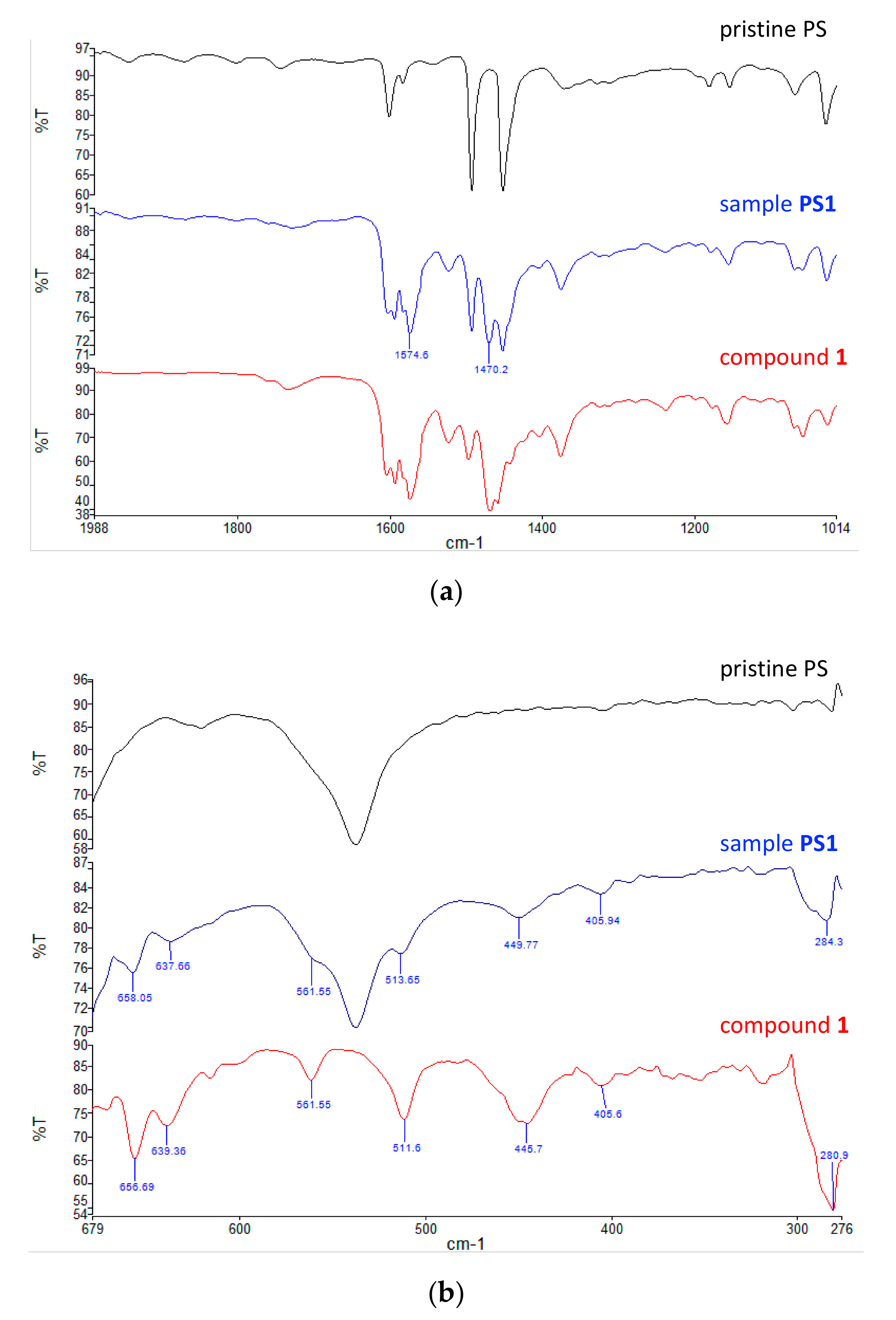
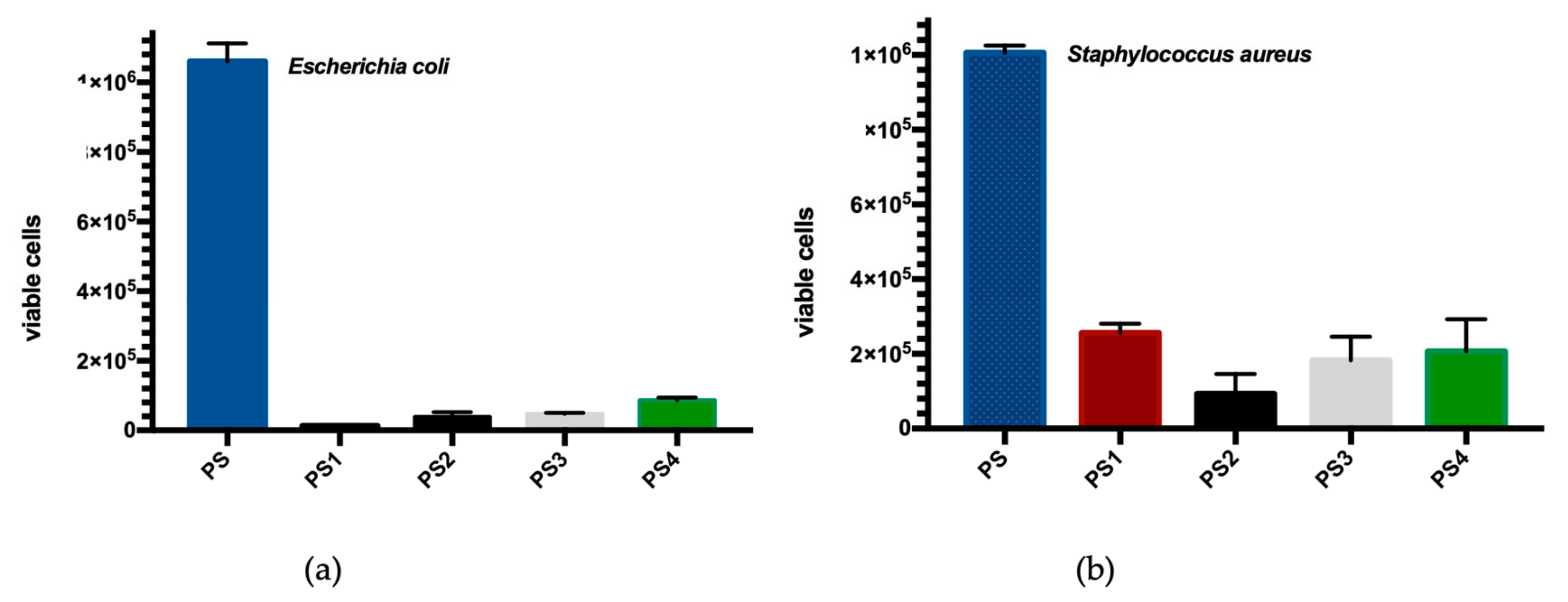
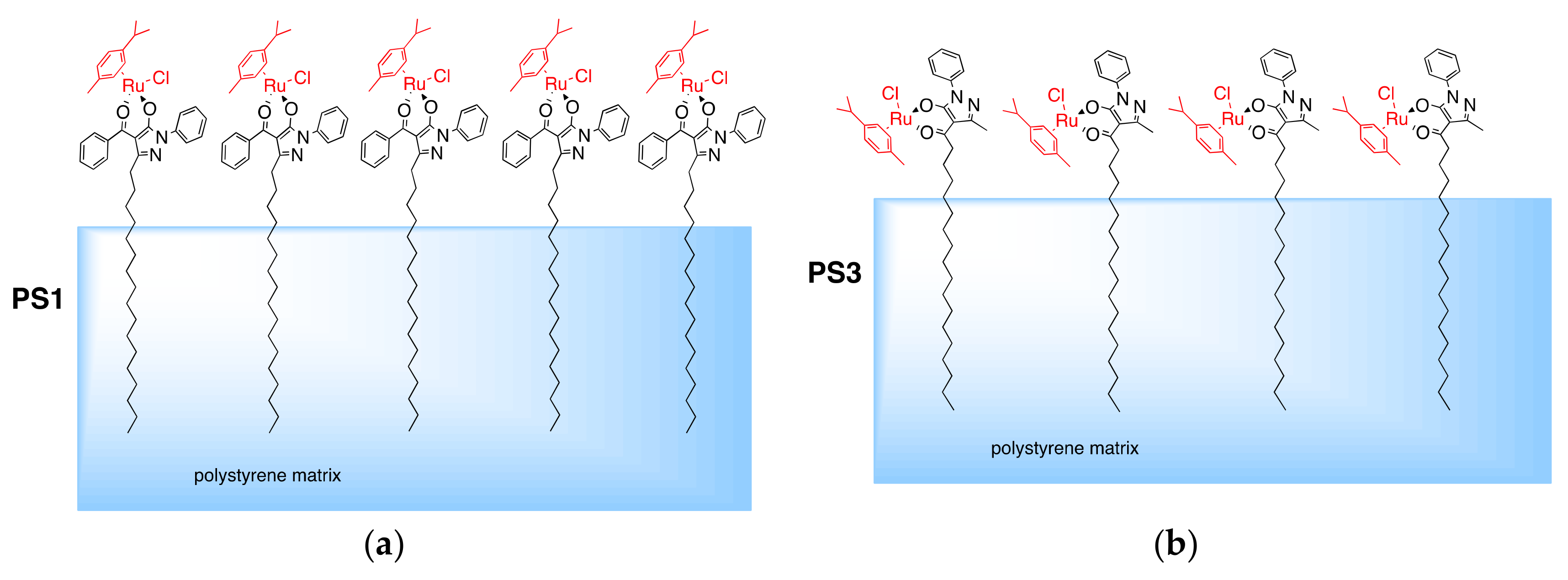
| Element | At. No. | Net | Mass [%] | Mass Norm. [%] | Atom | Abs. Error [%] (1 σ) | Rel. Error [%] (1 σ) |
|---|---|---|---|---|---|---|---|
| Carbon | 6 | 329219 | 89.71 | 72.65 | 82.81 | 9.62 | 10.73 |
| Nitrogen | 7 | 4366 | 8.79 | 7.12 | 6.96 | 1.44 | 16.34 |
| Oxygen | 8 | 15301 | 11.79 | 9.55 | 8.17 | 1.59 | 13.45 |
| Chlorine | 17 | 24173 | 3.03 | 2.46 | 0.95 | 0.13 | 4.24 |
| Ruthenium | 44 | 52600 | 10.15 | 8.22 | 1.11 | 0.37 | 3.60 |
| Sum | 123.48 | 100.00 | 100.00 |
© 2020 by the authors. Licensee MDPI, Basel, Switzerland. This article is an open access article distributed under the terms and conditions of the Creative Commons Attribution (CC BY) license (http://creativecommons.org/licenses/by/4.0/).
Share and Cite
Di Nicola, C.; Marchetti, F.; Pettinari, R.; Tombesi, A.; Pettinari, C.; Grappasonni, I.; Dyson, P.J.; Scuri, S. Tethering (Arene)Ru(II) Acylpyrazolones Decorated with Long Aliphatic Chains to Polystyrene Surfaces Provides Potent Antibacterial Plastics. Materials 2020, 13, 526. https://doi.org/10.3390/ma13030526
Di Nicola C, Marchetti F, Pettinari R, Tombesi A, Pettinari C, Grappasonni I, Dyson PJ, Scuri S. Tethering (Arene)Ru(II) Acylpyrazolones Decorated with Long Aliphatic Chains to Polystyrene Surfaces Provides Potent Antibacterial Plastics. Materials. 2020; 13(3):526. https://doi.org/10.3390/ma13030526
Chicago/Turabian StyleDi Nicola, Corrado, Fabio Marchetti, Riccardo Pettinari, Alessia Tombesi, Claudio Pettinari, Iolanda Grappasonni, Paul J. Dyson, and Stefania Scuri. 2020. "Tethering (Arene)Ru(II) Acylpyrazolones Decorated with Long Aliphatic Chains to Polystyrene Surfaces Provides Potent Antibacterial Plastics" Materials 13, no. 3: 526. https://doi.org/10.3390/ma13030526
APA StyleDi Nicola, C., Marchetti, F., Pettinari, R., Tombesi, A., Pettinari, C., Grappasonni, I., Dyson, P. J., & Scuri, S. (2020). Tethering (Arene)Ru(II) Acylpyrazolones Decorated with Long Aliphatic Chains to Polystyrene Surfaces Provides Potent Antibacterial Plastics. Materials, 13(3), 526. https://doi.org/10.3390/ma13030526








